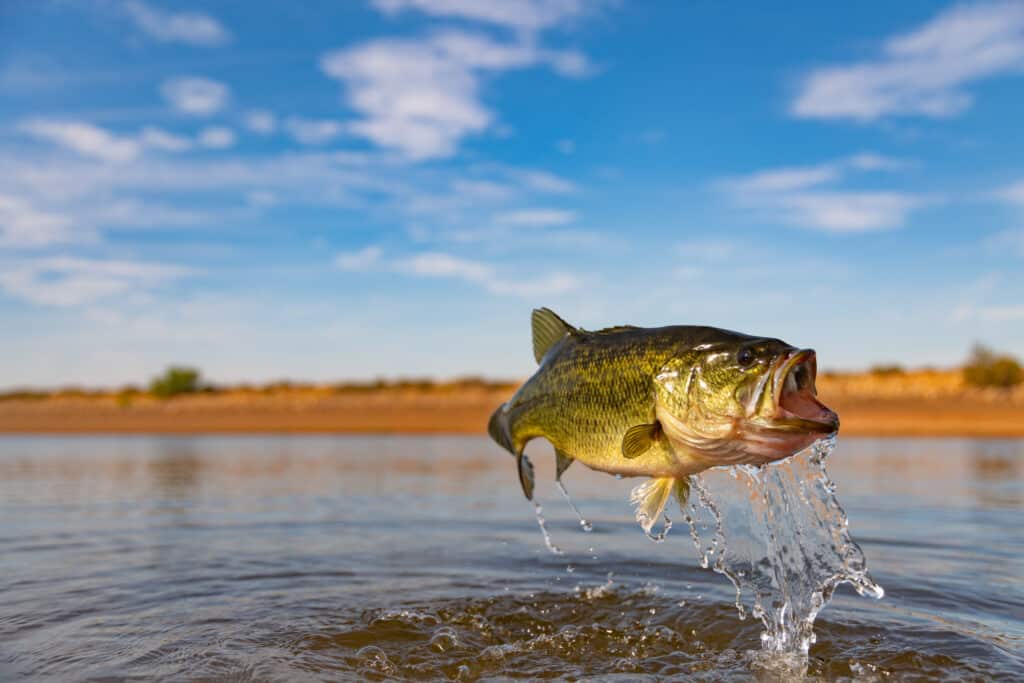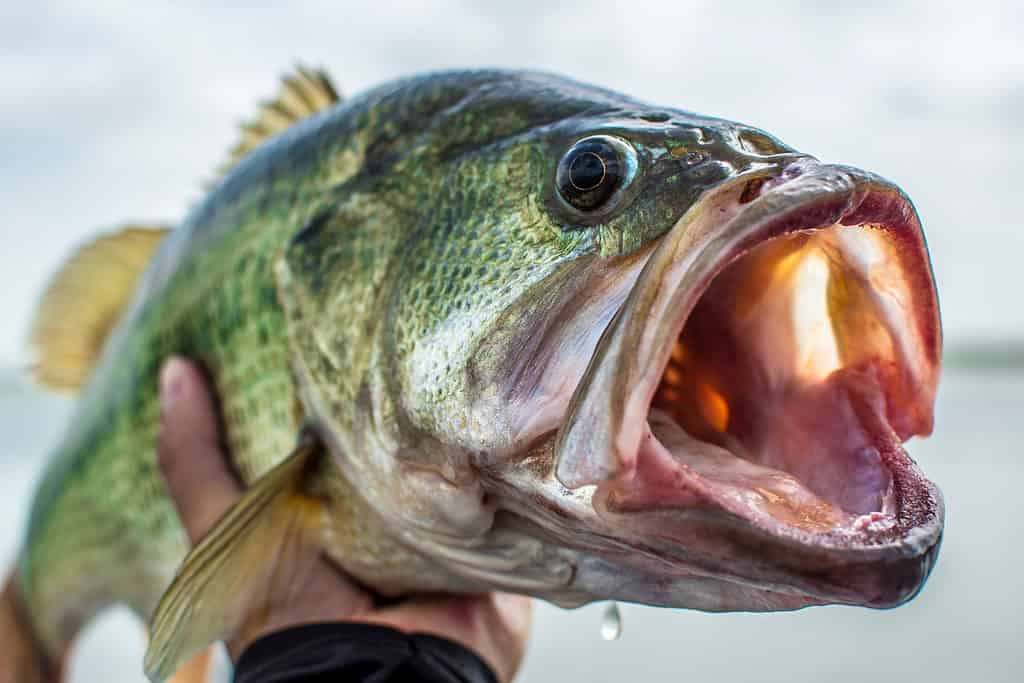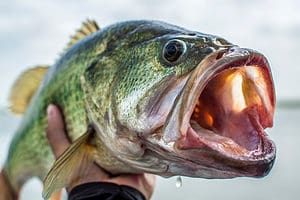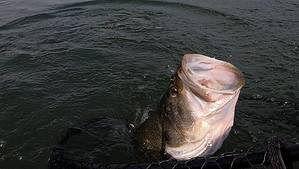The Empire State is notable for many things — it’s the fourth-most populous state in the United States, it’s home to some of the most popular tourist attractions in the world, and it’s even where the United Nations’ headquarters is located. But it’s also home to some of the best largemouth bass fishing destinations in North America, such as the Finger Lakes, Chautauqua Lake, and the St. Lawrence River. In this article, we’ll explore the largest largemouth bass ever caught in New York.
In addition, we’ll take a look at why the largemouth bass is so unique, how big largemouths typically get, and how New York’s state record compares to the current world record.
Interesting Facts About The Largemouth Bass
Taxonomically, the largemouth bass is one of 13 total species in the Micropterus genus. Most anglers know these fish as the black basses for the dark brown markings on their greenish bodies that can appear black in the water. This group includes species like the smallmouth, spotted, and redeye basses. However, the largemouth is by far the largest by average weight and length.
Interestingly, Micropterus translates to “small fin,” which is actually a bit of a misnomer. When French naturalist Count Lacépède originally defined the genus in 1802, the smallmouth bass specimen he was examining had a torn dorsal fin, making it look as if it had two small fins. The name stuck, and the rest is history!
Like the rest of its black bass brethren, the largemouth is native to North America. It mainly prefers warm, slow-moving, clear waters. However, it is incredibly hardy and can thrive in a wide range of freshwater habitats. As a result, you can find it in most U.S. states, particularly those along the eastern coast, as well as parts of southern Canada. It’s also invasive in various other parts of the world, most notably Japan, southern Africa, and most of Europe.
In addition to being the largest member of its genus, the largemouth is also the largest member of its whole scientific family, Centrarchidae, the freshwater sunfishes. Centrarchidae consists of 38 total species, including the bluegill and both known crappie species.

The largemouth is also the largest member of its whole scientific family,
Centrarchidae, the freshwater sunfishes.
©Ryno Botha/Shutterstock.com
How Big Do Largemouth Bass Get?
We’ve briefly touched on the largemouth bass’ prodigious size above, but how large do they actually get? The average adult largemouth typically reaches somewhere between 14 and 20 inches long. It isn’t terribly uncommon, though, for especially large specimens to exceed two feet in length!
The largemouth isn’t just a lengthy fish, either. It’s also very hefty and muscular, and individuals grow very quickly during their first two years of life. Fully mature largemouths can weigh anywhere from 5 to 15 pounds. Like many species, it is sexually dimorphic, so females are usually much larger than males. Many female largemouth basses can even weigh well over 20 pounds. This is especially common for females carrying large quantities of eggs during the species’ breeding season in the spring.
While largemouths technically reach sexual maturity at around one year of age, they can continue growing for many years beyond this point. Their maximum lifespan in the wild varies slightly depending on their particular habitat and diet. In ideal circumstances, they can live for 10 to 15 years.
It’s also worth noting that the largemouth’s massive size is a major factor in its apex predator status. It’s even capable of ambushing and eating prey up to half of the size of its own body by using its powerful abdominal muscles and wide mouth to suck in large amounts of water at high speeds! It uses these same muscles, in fact, to swim at speeds of up to 20 miles per hour! So this is another factor that makes it a fierce predator.
Largemouth Bass Fishing: A Brief History
Bass fishing as a hobby mainly developed in the United States in the mid-1800s. Specifically, the largemouth played a huge role in popularizing bass fishing in North America and worldwide.
While the largemouth bass had a wide native range to begin with, thanks to its hardy nature, the steam engine helped spread it further across the United States. Steam engines needed a lot of water to travel such long distances, so tank ponds at waypoints helped fuel them. Locals built these tank ponds by damming nearby creeks, many of which housed substantial populations of largemouth bass.
In turn, the ponds were stocked with largemouths, which were also hardy enough to be transported on the steam engines–usually in large water buckets from the tank ponds. As the species’ range expanded, anglers across the U.S. took notice. They began developing methods to catch this abundant yet feisty fish. Initially, fly fishing was the norm, as early fishers adapted their techniques for catching other native species like salmon and trout to catch largemouths.
Eventually, anglers tailored their methods to catching black bass species like the largemouth. Floating wooden lures became common in the early 1900s. After a post-war fishing boom in the 1950s, increased industrialization made plastic worm-like lures the standard. At the same time, the U.S. Department of Agriculture continued stocking ponds with black basses.
By the 1960s, the largemouth bass was becoming one of the most sought-after game fish in the world as it was being introduced to areas like east Asia and Europe. The first B.A.S.S. Federation tournament launched in 1967, with the Bassmaster Classic launching in 1971. Today, anglers use a wide range of lures and techniques to catch largemouth bass. Live baits and moving swimbaits are especially common.
What Is The Largest Largemouth Bass Ever Caught In New York?
Now that we’ve looked at some interesting facts about the largemouth bass and its important role in the bass fishing hobby let’s learn more about the largest specimen ever caught in New York! Like most U.S. states, New York’s Department of Environmental Conservation keeps track of state fishing records for various popular game fish species.
According to their records, the largest largemouth bass caught in the Empire State was a prodigious 11 pounds, 4 ounces. While this doesn’t quite measure up to other nearby state records like Massachusetts’ 15-pounder, it’s still quite unique and impressive for a few reasons. For starters, the fish in question was caught by angler John Higbie at Otsego County’s Buckhorn Lake — all the way back in 1987! This means his record has stood unbeaten for over 35 years.
Additionally, local news records stated Higbie’s record outweighed the previous state record from 12 years prior (in 1975) by around 8 ounces. It was a rather lengthy bass as well at 25.5 inches long and reportedly had a girth of 21 inches. He used a spinnerbait, a fishing lure that combines a moving swimbait with the design of a spoon lure.
Buckhorn Lake, where Higbie caught the record-breaking bass, is a rather small yet culturally important fishing spot in southeast New York’s Otsego County. The lake is also known to locals as The Fly. It drains into a nearby creek which flows into the much larger Susquehanna River.

The largest largemouth bass caught in New York State was a prodigious 11 pounds, 4 ounces back in 1987.
©Pierre Rebollar/Shutterstock.com
Where Is Buckhorn Lake Located on a Map?
Buckhorn Lake lies to the north and west of the Susquehanna River. It also lies directly to the south of County Forest and southeast of Rockdale.
What Is The Largest Largemouth Bass Ever Caught In The World?
Although John Higbie’s 11-plus-pound bass is a substantial catch, New York’s largest largemouth bass is actually only around half the size of the current world record! That’s right–the largest largemouth bass ever caught in the world was an astonishing 22 pounds, 4.97 ounces.
But what’s even more unique and unusual about this once-in-a-lifetime catch is that the angler responsible for it didn’t even catch it in North America, where the species is native. A Japanese angler, Manabu Kurita, caught this monster of a fish at Japan’s Lake Biwa on July 2nd, 2009. Notably, Lake Biwa is one of Japan’s largest and oldest lakes. It’s also one of the most ancient lakes in the world. It’s also a culturally significant fishing spot that is home to a huge variety of game fish and water birds.
However, there’s still a little more to this story, as Kurita actually shares the world record with another angler whose record was established more than 90 years ago in 1932. This is because an I.G.F.A. regulation states new game fishing records must be more than two ounces heavier than the previously established record.
The previous world record, set by American angler George W. Perry from Rentz, Georgia, was a 22-pound, 4-ounce largemouth bass. He caught the fish at Georgia’s Montgomery Lake on June 2nd, 1932, when he was only 19 years old. Kurita’s bass only outweighs Perry’s by just under an ounce.
Though he sadly passed away in 1974, Perry’s record has been immortalized with a historic marker near Montgomery Lake. He’s also fondly remembered by many in the bass fishing hobby. Only time will tell if his and Kurita’s records will be beaten in the future!
The photo featured at the top of this post is © iStock.com/stammphoto
Thank you for reading! Have some feedback for us? Contact the AZ Animals editorial team.






